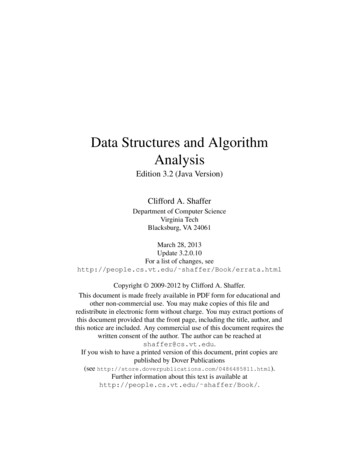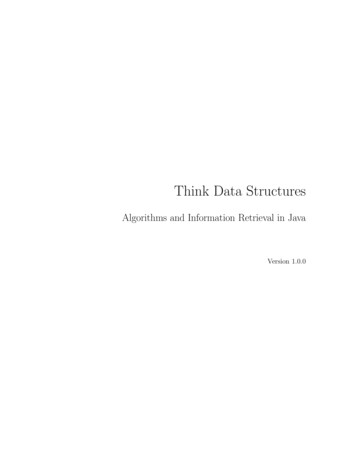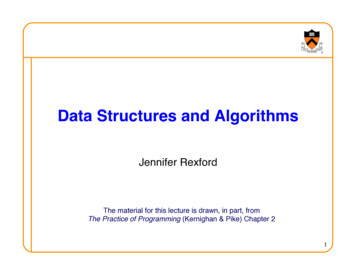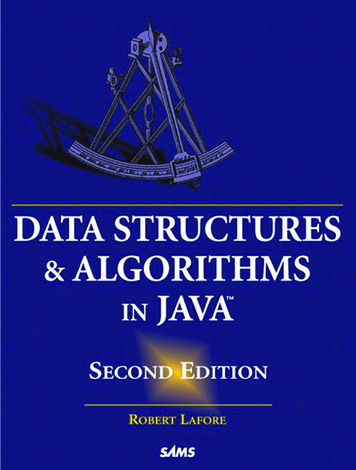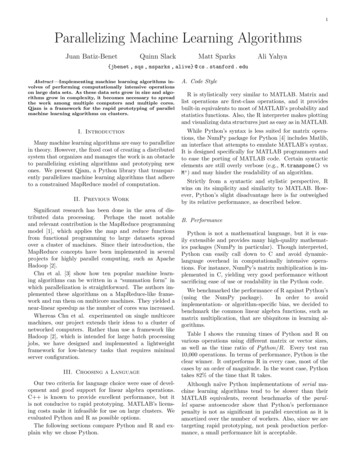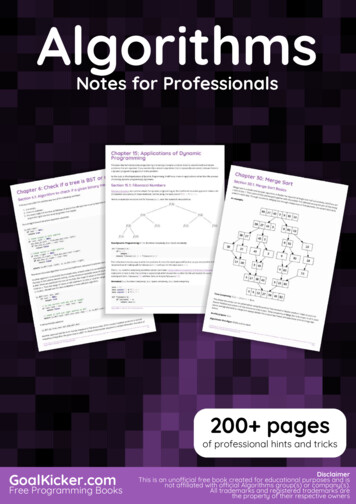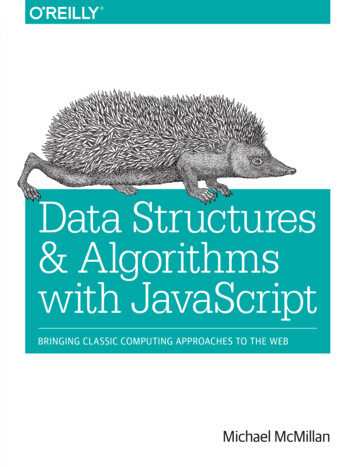
Transcription
Data Structures and Algorithmswith JavaScriptMichael McMillan
Data Structures and Algorithms with JavaScriptby Michael McMillanCopyright 2014 Michael McMillan. All rights reserved.Printed in the United States of America.Published by O’Reilly Media, Inc., 1005 Gravenstein Highway North, Sebastopol, CA 95472.O’Reilly books may be purchased for educational, business, or sales promotional use. Online editions arealso available for most titles (http://my.safaribooksonline.com). For more information, contact our corporate/institutional sales department: 800-998-9938 or corporate@oreilly.com.Editors: Brian MacDonald and Meghan BlanchetteProduction Editor: Melanie YarbroughCopyeditor: Becca FreedProofreader: Amanda KerseyIndexer: Ellen Troutman-ZaigMarch 2014:Cover Designer: Karen MontgomeryInterior Designer: David FutatoIllustrators: Rebecca Demarest and Cynthia ClarkeFehrenbachFirst EditionRevision History for the First Edition:2014-03-06:First releaseSee http://oreilly.com/catalog/errata.csp?isbn 9781449364939 for release details.Nutshell Handbook, the Nutshell Handbook logo, and the O’Reilly logo are registered trademarks of O’ReillyMedia, Inc. Data Structures and Algorithms with JavaScript, the image of an amur hedgehog, and relatedtrade dress are trademarks of O’Reilly Media, Inc.Many of the designations used by manufacturers and sellers to distinguish their products are claimed astrademarks. Where those designations appear in this book, and O’Reilly Media, Inc. was aware of a trademarkclaim, the designations have been printed in caps or initial caps.While every precaution has been taken in the preparation of this book, the publisher and authors assumeno responsibility for errors or omissions, or for damages resulting from the use of the information containedherein.ISBN: 978-1-449-36493-9[LSI]
Table of ContentsPreface. . . . . . . . . . . . . . . . . . . . . . . . . . . . . . . . . . . . . . . . . . . . . . . . . . . . . . . . . . . . . . . . . . . . . . . ix1. The JavaScript Programming Environment and Model. . . . . . . . . . . . . . . . . . . . . . . . . . . . 1The JavaScript EnvironmentJavaScript Programming PracticesDeclaring and Intializing VariablesArithmetic and Math Library Functions in JavaScriptDecision ConstructsRepetition ConstructsFunctionsVariable ScopeRecursionObjects and Object-Oriented ProgrammingSummary123346781010122. Arrays. . . . . . . . . . . . . . . . . . . . . . . . . . . . . . . . . . . . . . . . . . . . . . . . . . . . . . . . . . . . . . . . . . . . 13JavaScript Arrays DefinedUsing ArraysCreating ArraysAccessing and Writing Array ElementsCreating Arrays from StringsAggregate Array OperationsAccessor FunctionsSearching for a ValueString Representations of ArraysCreating New Arrays from Existing ArraysMutator FunctionsAdding Elements to an ArrayRemoving Elements from an Array13131415151617171818191920iii
Adding and Removing Elements from the Middle of an ArrayPutting Array Elements in OrderIterator FunctionsNon–Array-Generating Iterator FunctionsIterator Functions That Return a New ArrayTwo-Dimensional and Multidimensional ArraysCreating Two-Dimensional ArraysProcessing Two-Dimensional Array ElementsJagged ArraysArrays of ObjectsArrays in ObjectsExercises2122232325272728303031333. Lists. . . . . . . . . . . . . . . . . . . . . . . . . . . . . . . . . . . . . . . . . . . . . . . . . . . . . . . . . . . . . . . . . . . . . . 35A List ADTA List Class ImplementationAppend: Adding an Element to a ListRemove: Removing an Element from a ListFind: Finding an Element in a ListLength: Determining the Number of Elements in a ListtoString: Retrieving a List’s ElementsInsert: Inserting an Element into a ListClear: Removing All Elements from a ListContains: Determining if a Given Value Is in a ListTraversing a ListIterating Through a ListA List-Based ApplicationReading Text FilesUsing Lists to Manage a KioskExercises353637373838383939404041424243474. Stacks. . . . . . . . . . . . . . . . . . . . . . . . . . . . . . . . . . . . . . . . . . . . . . . . . . . . . . . . . . . . . . . . . . . . 49Stack OperationsA Stack ImplementationUsing the Stack ClassMultiple Base ConversionsPalindromesDemonstrating RecursionExercises495053535456575. Queues. . . . . . . . . . . . . . . . . . . . . . . . . . . . . . . . . . . . . . . . . . . . . . . . . . . . . . . . . . . . . . . . . . . 59Queue Operationsiv Table of Contents59
An Array-Based Queue Class ImplementationUsing the Queue Class: Assigning Partners at a Square DanceSorting Data with QueuesPriority QueuesExercises60636770726. Linked Lists. . . . . . . . . . . . . . . . . . . . . . . . . . . . . . . . . . . . . . . . . . . . . . . . . . . . . . . . . . . . . . . . 73Shortcomings of ArraysLinked Lists DefinedAn Object-Based Linked List DesignThe Node ClassThe Linked List ClassInserting New NodesRemoving Nodes from a Linked ListDoubly Linked ListsCircularly Linked ListsOther Linked List FunctionsExercises73747575767678818586867. Dictionaries. . . . . . . . . . . . . . . . . . . . . . . . . . . . . . . . . . . . . . . . . . . . . . . . . . . . . . . . . . . . . . . 89The Dictionary ClassAuxiliary Functions for the Dictionary ClassAdding Sorting to the Dictionary ClassExercises899193948. Hashing. . . . . . . . . . . . . . . . . . . . . . . . . . . . . . . . . . . . . . . . . . . . . . . . . . . . . . . . . . . . . . . . . . . 97An Overview of HashingA Hash Table ClassChoosing a Hash FunctionA Better Hash FunctionHashing Integer KeysStoring and Retrieving Data in a Hash TableHandling CollisionsSeparate ChainingLinear ProbingExercises9798981011031061071071091119. Sets. . . . . . . . . . . . . . . . . . . . . . . . . . . . . . . . . . . . . . . . . . . . . . . . . . . . . . . . . . . . . . . . . . . . . 113Fundamental Set Definitions, Operations, and PropertiesSet DefinitionsSet OperationsThe Set Class Implementation113113114114Table of Contents v
More Set OperationsExercises11612010. Binary Trees and Binary Search Trees. . . . . . . . . . . . . . . . . . . . . . . . . . . . . . . . . . . . . . . . . 121Trees DefinedBinary Trees and Binary Search TreesBuilding a Binary Search Tree ImplementationTraversing a Binary Search TreeBST SearchesSearching for the Minimum and Maximum ValueSearching for a Specific ValueRemoving Nodes from a BSTCounting 11. Graphs and Graph Algorithms. . . . . . . . . . . . . . . . . . . . . . . . . . . . . . . . . . . . . . . . . . . . . . . 139Graph DefinitionsReal-World Systems Modeled by GraphsThe Graph ClassRepresenting VerticesRepresenting EdgesBuilding a GraphSearching a GraphDepth-First SearchBreadth-First SearchFinding the Shortest PathBreadth-First Search Leads to Shortest PathsDetermining PathsTopological SortingAn Algorithm for Topological SortingImplementing the Topological Sorting 915015115215215712. Sorting Algorithms. . . . . . . . . . . . . . . . . . . . . . . . . . . . . . . . . . . . . . . . . . . . . . . . . . . . . . . . 159An Array Test BedGenerating Random DataBasic Sorting AlgorithmsBubble SortSelection SortInsertion SortTiming Comparisons of the Basic Sorting AlgorithmsAdvanced Sorting Algorithmsvi Table of Contents159161161162165167168170
The Shellsort AlgorithmThe Mergesort AlgorithmThe Quicksort AlgorithmExercises17117618118613. Searching Algorithms. . . . . . . . . . . . . . . . . . . . . . . . . . . . . . . . . . . . . . . . . . . . . . . . . . . . . . 187Sequential SearchSearching for Minimum and Maximum ValuesUsing Self-Organizing DataBinary SearchCounting OccurrencesSearching Textual DataExercises18719019319620020220514. Advanced Algorithms. . . . . . . . . . . . . . . . . . . . . . . . . . . . . . . . . . . . . . . . . . . . . . . . . . . . . . 207Dynamic ProgrammingA Dynamic Programming Example: Computing Fibonacci NumbersFinding the Longest Common SubstringThe Knapsack Problem: A Recursive SolutionThe Knapsack Problem: A Dynamic Programming SolutionGreedy AlgorithmsA First Greedy Algorithm Example: The Coin-Changing ProblemA Greedy Algorithm Solution to the Knapsack ProblemExercises207208211214215217217218220Index. . . . . . . . . . . . . . . . . . . . . . . . . . . . . . . . . . . . . . . . . . . . . . . . . . . . . . . . . . . . . . . . . . . . . . . 221Table of Contents vii
PrefaceOver the past few years, JavaScript has been used more and more as a server-side com‐puter programming language owing to platforms such as Node.js and SpiderMonkey.Now that JavaScript programming is moving out of the browser, programmers will findthey need to use many of the tools provided by more conventional languages, such asC and Java. Among these tools are classic data structures such as linked lists, stacks,queues, and graphs, as well as classic algorithms for sorting and searching data. Thisbook discusses how to implement these data structures and algorithms for server-sideJavaScript programming.JavaScript programmers will find this book useful because it discusses how to implementdata structures and algorithms within the constraints that JavaScript places them, suchas arrays that are really objects, overly global variables, and a prototype-based objectsystem. JavaScript has an unfair reputation as a “bad” programming language, but thisbook demonstrates how you can use JavaScript to develop efficient and effective datastructures and algorithms using the language’s “good parts.”Why Study Data Structures and AlgorithmsI am assuming that many of you reading this book do not have a formal education incomputer science. If you do, then you already know why studying data structures andalgorithms is important. If you do not have a degree in computer science or haven’tstudied these topics formally, you should read this section.The computer scientist Nicklaus Wirth wrote a computer programming textbook titledAlgorithms Data Structures Programs (Prentice-Hall). That title is the essence ofcomputer programming. Any computer program that goes beyond the trivial “Hello,world!” will usually require some type of structure to manage the data the program iswritten to manipulate, along with one or more algorithms for translating the data fromits input form to its output form.ix
For many programmers who didn’t study computer science in school, the only datastructure they are familiar with is the array. Arrays are great for some problems, but formany complex problems, they are simply not sophisticated enough. Most experiencedprogrammers will admit that for many programming problems, once they come up withthe proper data structure, the algorithms needed to solve the problem are easier to designand implement.An example of a data structure that leads to efficient algorithms is the binary search tree(BST). A binary search tree is designed so that it is easy to find the minimum andmaximum values of a set of data, yielding an algorithm that is more efficient than thebest search algorithms available. Programmers unfamiliar with BSTs will instead prob‐ably use a simpler data structure that ends up being less efficient.Studying algorithms is important because there is always more than one algorithm thatcan be used to solve a problem, and knowing which ones are the most efficient is im‐portant for the productive programmer. For example, there are at least six or seven waysto sort a list of data, but knowing that the Quicksort algorithm is more efficient thanthe selection sort algorithm will lead to a much more efficient sorting process. Or thatit’s fairly easy to implement a sequential or linear search algorithm for a list of data, butknowing that the binary sort algorithm can sometimes be twice as efficient as the se‐quential search will lead to a better program.The comprehensive study of data structures and algorithms teaches you not only whichdata structures and which algorithms are the most efficient, but you also learn how todecide which data structures and which algorithms are the most appropriate for theproblem at hand. There will often be trade-offs involved when writing a program, es‐pecially in the JavaScript environment, and knowing the ins and outs of the various datastructures and algorithms covered in this book will help you make the proper decisionfor any particular programming problem you are trying to solve.What You Need for This BookThe programming environment we use in this book is the JavaScript shell based onthe SpiderMonkey JavaScript engine. Chapter 1 provides instructions on downloadingthe shell for your environment. Other shells will work as well, such as the Node.js Java‐Script shell, though you will have to make some translations for the programs in thebook to work in Node. Other than the shell, the only thing you need is a text editor forwriting your JavaScript programs.x Preface
Organization of the Book Chapter 1 presents an overview of the JavaScript language, or at least the featuresof the JavaScript language used in this book. This chapter also demonstrates throughuse the programming style used throughout the other chapters. Chapter 2 discusses the most common data structure in computer programming:the array, which is native to JavaScript. Chapter 3 introduces the first implemented data structure: the list. Chapter 4 covers the stack data structure. Stacks are used throughout computerscience in both compiler and operating system implementations. Chapter 5 discusses queue data structures. Queues are an abstraction of the linesyou stand in at a bank or the grocery store. Queues are used extensively in simulationsoftware where data has to be lined up before it is processed. Chapter 6 covers Linked lists. A linked list is a modification of the list data structure,where each element is a separate object linked to the objects on either side of it.Linked lists are efficient when you need to perform multiple insertions and dele‐tions in your program. Chapter 7 demonstrates how to build and use dictionaries, which are data structuresthat store data as key-value pairs. One way to implement a dictionary is to use a hash table, and Chapter 8 discusseshow to build hash tables and the hash algorithms that are used to store data in thetable. Chapter 9 covers the set data structure. Sets are often not covered in data structurebooks, but they can be useful for storing data that is not supposed to have duplicatesin the data set. Binary trees and binary search trees are the subject of Chapter 10. As mentionedearlier, binary search trees are useful for storing data that needs to be stored orig‐inally in sorted form. Chapter 11 covers graphs and graph algorithms. Graphs are used to represent datasuch as the nodes of a computer network or the cities on a map. Chapter 12 moves from data structures to algorithms and discusses various algo‐rithms for sorting data, including both simple sorting algorithms that are easy toimplement but are not efficient for large data sets, and more complex algorithmsthat are appropriate for larger data sets. Chapter 13 also covers algorithms, this time searching algorithms such as sequentialsearch and binary search. The last chapter of the book, Chapter 14, discusses a couple more advanced algo‐rithms for working with data—dynamic programming and greedy algorithms.Preface xi
These algorithms are useful for solving hard problems where a more traditionalalgorithm is either too slow or too hard to implement. We examine some classicproblems for both dynamic programming and greedy algorithms in the chapter.Conventions Used in This BookThe following typographical conventions are used in this book:ItalicIndicates new terms, URLs, email addresses, filenames, and file extensions.Constant widthUsed for program listings, as well as within paragraphs to refer to program elementssuch as variable or function names, databases, data types, environment variables,statements, and keywords.Constant width boldShows commands or other text that should be typed literally by the user.Constant width italicShows text that should be replaced with user-supplied values or by values deter‐mined by context.Using Code ExamplesSupplemental material (code examples, exercises, etc.) is available for download athttps://github.com/oreillymedia/data structures and algorithms using javascript.This book is here to help you get your job done. In general, if example code is offeredwith this book, you may use it in your programs and documentation. You do not needto contact us for permission unless you’re reproducing a significant portion of the code.For example, writing a program that uses several chunks of code from this book doesnot require permission. Selling or distributing a CD-ROM of examples from O’Reillybooks does require permission. Answering a question by citing this book and quotingexample code does not require permission. Incorporating a significant amount of ex‐ample code from this book into your product’s documentation does require permission.We appreciate, but do not require, attribution. An attribution usually includes the title,author, publisher, and ISBN. For example: “Data Structures and Algorithms Using Java‐Script by Michael McMillian (O’Reilly). Copyright 2014 Michael McMillan,978-1-449-36493-9.”If you feel your use of code examples falls outside fair use or the permission given above,feel free to contact us at permissions@oreilly.com.xii Preface
Safari Books OnlineSafari Books Online is an on-demand digital library thatdelivers expert content in both book and video form fromthe world’s leading authors in technology and business.Technology professionals, software developers, web designers, and business and crea‐tive professionals use Safari Books Online as their primary resource for research, prob‐lem solving, learning, and certification training.Safari Books Online offers a range of product mixes and pricing programs for organi‐zations, government agencies, and individuals. Subscribers have access to thousands ofbooks, training videos, and prepublication manuscripts in one fully searchable databasefrom publishers like O’Reilly Media, Prentice Hall Professional, Addison-Wesley Pro‐fessional, Microsoft Press, Sams, Que, Peachpit Press, Focal Press, Cisco Press, JohnWiley & Sons, Syngress, Morgan Kaufmann, IBM Redbooks, Packt, Adobe Press, FTPress, Apress, Manning, New Riders, McGraw-Hill, Jones & Bartlett, Course Technol‐ogy, and dozens more. For more information about Safari Books Online, please visit usonline.How to Contact UsPlease address comments and questions concerning this book to the publisher:O’Reilly Media, Inc.1005 Gravenstein Highway NorthSebastopol, CA 95472800-998-9938 (in the United States or Canada)707-829-0515 (international or local)707-829-0104 (fax)We have a web page for this book, where we list errata, examples, and any additionalinformation. You can access this page at http://oreil.ly/data structures algorithms JS.To comment or ask technical questions about this book, send email to bookquestions@oreilly.com.For more information about our books, courses, conferences, and news, see our websiteat http://www.oreilly.com.Find us on Facebook: http://facebook.com/oreillyFollow us on Twitter: http://twitter.com/oreillymediaWatch us on YouTube: http://www.youtube.com/oreillymediaPreface xiii
AcknowledgmentsThere are always lots of people to thank when you’ve finished writing a book. I’d like tothank my acquisition editor, Simon St. Laurent, for believing in this book and gettingme started writing it. Meghan Blanchette worked hard to keep me on schedule, and ifI went off schedule, it definitely wasn’t her fault. Brian MacDonald worked extremelyhard to make this book as understandable as possible, and he helped make several partsof the text much clearer than I had written them originally. I also want to thank mytechnical reviewers for reading all the text as well as the code, and for pointing out placeswhere both my prose and my code needed to be clearer. My colleague and illustrator,Cynthia Fehrenbach, did an outstanding job translating my chicken scratchings intocrisp, clear illustrations, and she deserves extra praise for her willingness to redrawseveral illustrations at the very last minute. Finally, I’d like to thank all the people atMozilla for designing an excellent JavaScript engine and shell and writing some excellentdocumentation for using both the language and the shell.xiv Preface
CHAPTER 1The JavaScript Programming Environmentand ModelThis chapter describes the JavaScript programming environment and the programmingconstructs we’ll use in this book to define the various data structures and algorithmsexamined.The JavaScript EnvironmentJavaScript has historically been a programming language that ran only inside a webbrowser. However, in the past few years, there has been the development of JavaScriptprogramming environments that can be run from the desktop, or similarly, from aserver. In this book we use one such environment: the JavaScript shell that is part ofMozilla’s comprehensive JavaScript environment known as SpiderMonkey.To download the JavaScript shell, navigate to the Nightly Build web page. Scroll to thebottom of the page and pick the download that matches your computer system.Once you’ve downloaded the program, you have two choices for using the shell. Youcan use it either in interactive mode or to interpret JavaScript programs stored in afile. To use the shell in interactive mode, type the command js at a command prompt.The shell prompt, js , will appear and you are ready to start entering JavaScript ex‐pressions and statements.The following is a typical interaction with the shell:js 1js 3js js 12411 2var num 1;num*1241
js for (var i 1; i 6; i) {print(i);}12345js You can enter arithmetic expressions and the shell will immediately evaluate them. Youcan write any legal JavaScript statement and the shell will immediately evaluate it aswell. The interactive shell is great for exploring JavaScript statements to discover howthey work. To leave the shell when you are finished, type the command quit().The other way to use the shell is to have it interpret complete JavaScript programs. Thisis how we will use the shell throughout the rest of the book.To use the shell to intepret programs, you first have to create a file that contains aJavaScript program. You can use any text editor, making sure you save the file as plaintext. The only requirement is that the file must have a .js extension. The shell has to seethis extension to know the file is a JavaScript program.Once you have your file saved, you interpret it by typing the js command followed bythe full filename of your program. For example, if you saved the for loop code fragmentthat’s shown earlier in a file named loop.js, you would enter the following:c:\js js loop.jswhich would produce the following output:12345After the program is executed, control is returned to the command prompt.JavaScript Programming PracticesIn this section we discuss how we use JavaScript. We realize that programmers havedifferent styles and practices when it comes to writing programs, and we want to de‐scribe ours here at the beginning of the book so that you’ll understand the more complexcode we present in the rest of the book. This isn’t a tutorial on using JavaScript but isjust a guide to how we use the fundamental constructs of the language.2 Chapter 1: The JavaScript Programming Environment and Model
Declaring and Intializing VariablesJavaScript variables are global by default and, strictly speaking, don’t have to be declaredbefore using. When a JavaScript variable is initialized without first being declared, itbecomes a global variable. In this book, however, we follow the convention used withcompiled languages such as C and Java by declaring all variables before their firstuse. The added benefit to doing this is that declared variables are created as local vari‐ables. We will talk more about variable scope later in this chapter.To declare a variable in JavaScript, use the keyword var followed by a variable name,and optionally, an assignment expression. Here are some examples:varvarvarvarvarnumber;name;rate 1.2;greeting "Hello, world!";flag false;Arithmetic and Math Library Functions in JavaScriptJavaScript utilizes the standard arithmetic operators: (addition) - (subtraction) * (multiplication) / (division) % (modulo)JavaScript also has a math library you can use for advanced functions such as squareroot, absolute value, and the trigonometric functions. The arithmetic operators followthe standard order of operations, and parentheses can be used to modify that order.Example 1-1 shows some examples of performing arithmetic in JavaScript, as well asexamples of using several of the mathematical functions.Example 1-1. Arithmetic and math functions in JavaScriptvar x 3;var y 1.1;print(x y);print(x * y);print((x y)*(x-y));var z 9;print(Math.sqrt(z));print(Math.abs(y/x));The output from this program is:JavaScript Programming Practices 3
6666667If you don’t want or need the precision shown above, you can format a number to afixed precision:var x 3;var y 1.1;var z x * y;print(z.toFixed(2)); // displays 3.30Decision ConstructsDecision constructs allow our programs to make decisions on what programmingstatements to execute based on a Boolean expression. The two decision constructs weuse in this book are the if statement and the switch statement.The if statement comes in three forms: The simple if statement The if-else statement The if-else if statementExample 1-2 shows how to write a simple if statement.Example 1-2. The simple if statementvar mid 25;var high 50;var low 1;var current 13;var found -1;if (current mid) {mid (current-low) / 2;}Example 1-3 demonstrates the if-else statement.Example 1-3. The if-else statementvar mid 25;var high 50;var low 1;var current 13;var found -1;if (current mid) {mid (current-low) / 2;}4 Chapter 1: The JavaScript Programming Environment and Model
else {mid (current high) / 2;}Example 1-4 illustrates the if-else if statement.Example 1-4. The if-else if statementvar mid 25;var high 50;var low 1;var current 13;var found -1;if (current mid) {mid (current-low) / 2;}else if (current mid) {mid (current high) / 2;}else {found current;}The other decision structure we use in this book is the switch statement. This statementprovides a cleaner, more structured construction when you have several simple deci‐sions to make. Example 1-5 demonstrates how the switch statement works.Example 1-5. The switch statementputstr("Enter a month number: ");var monthNum readline();var monthName;switch (monthNum) {case "1":monthName "January";break;case "2":monthName "February";break;case "3":monthName "March";break;case "4":monthName "April";break;case "5":monthName "May";break;case "6":monthName "June";break;case "7":JavaScript Programming Practices 5
monthName "July";break;case "8":monthName "August";break;case "9":monthName "September";break;case "10":monthName "October";break;case "11":monthName "November";break;case "12":monthName "December";break;default:print("Bad input");}Is this the most efficient way to solve this problem? No, but it does a great job of dem‐onstrating how the switch statement works.One major difference between the JavaScript switch statement and switch statementsin other programming languages is that the expression that is being tested in the state‐ment can be of any data type, as opposed to an integral data type, as required by languagessuch as C and Java. In fact, you’ll notice in the previous example that we use themonth numbers as strings, rather than converting them to numbers, since we can com‐pare strings using the switch statement in JavaScript.Repetition ConstructsMany of the algorithms we study in this book are repetitive in nature. We use tworepetition constructs in this book—the while loop and the for loop.When we want to execute a set of statements while a condition is true, we use a whileloop. Example 1-6 demonstrates how the while loop works.Example 1-6. The while loopvar number 1;var sum 0;while (number 11) {sum number; number;}print(sum); // displays 556 Chapter 1: The JavaScript Programming Environment and Model
When we want to execute a set of statements a specified number of times, we use a forloop. Example 1-7 uses a for loop to sum the integers 1 through 10.Example 1-7. Summing integers using a for loopvar number 1;var sum 0;for (var number 1; number 11; number ) {sum number;}print(sum); // displays 55for loops are also used frequently to access the elements of an array, as shown inExample 1-8.Example 1-8. Using a for loop with an arrayvar numbers [3, 7, 12, 22, 100];var sum 0;for (var i 0; i numbers.length; i) {sum numbers[i];}print(sum); // displays 144FunctionsJavaScript provides the means to define both value-returning functions and functionsthat don’t return values (sometimes called subprocedures or void functions).Example 1-9 demonstrates how value-returning functions are defined and called inJavaScript.Example 1-9. A value-returning functionfunction factorial(number) {var product 1;for (var i number; i 1; --i) {product * i;}return product;}print(factorial(4)); // displays 24print(factorial(5)); // displays 120print(factorial(10)); // displays 3628800Example 1-10 illustrates how to write a function that is used not for its return value, butfor the operations it performs.JavaScript Programming Practices 7
Example 1-10. A subprocedure or void function in JavaScriptfunction curve(arr, amount) {for (var i 0; i arr.length; i) {arr[i] amount;}}var grades [77, 73, 74, 81, 90];curve(grades, 5);print(grades); // displays 82,78,79,86,95All function parameters in JavaScript are passed by value, and ther
C and Java. Among these tools are classic data structures such as linked lists, stacks, queues, and graphs, as well as classic algorithms for sorting and searching data. This book discusses how to implement these data structures and al
